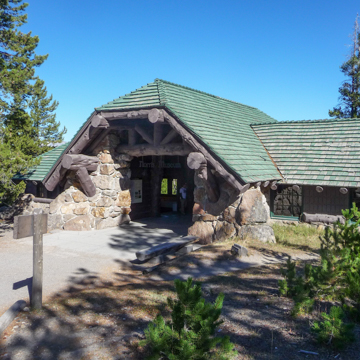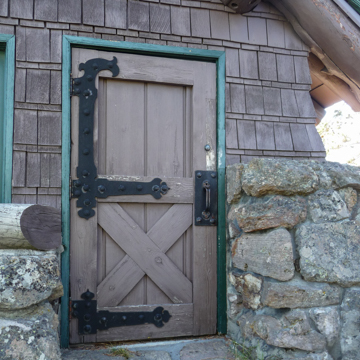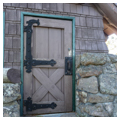You are here
Norris Geyser Basin Museum
The Norris Museum, the most imposing of the three extant trailside museums in Yellowstone National Park, is set within a clearing of a lodgepole pine forest at the south edge of Norris Geyser Basin. The low-slung building with its extended roof overhangs appears to hug the ground. The south facing facade is composed of large, undressed stones set in full-height, masonry piers that support a trussed, clipped-gable structure of large diameter peeled, knotty, and painted wood logs. The cavernous mouth of its open entryway effectively draws visitors into a 22-foot-wide, 20-foot-high passage leading directly to a terrace from which to view the geysers. Interior exhibits are housed in flanking wings perpendicular to this central passageway. These wings, subordinate in height and treatment to the main entry, have wood-framed walls finished with wood shingles laid in alternating tall and short courses. The solid walls are penetrated with full-height picture windows with nine divided lights. Juxtaposed against the substantial stone treatment, these windows provide transparency and natural illumination.
In 1995 new exhibits on geothermal geology, the features of the Norris Geyser Basin, and life in thermal areas were installed. National Park Service interpreters staff an information desk located in the passageway. An adjacent former restroom facility of matching architectural style houses a bookstore.
References
Bryant, Harold C., and Wallace W. Atwood, Jr. Research and Education in the National Parks - Part I: The Educational Program in the National Parks. Washington, D.C.: U.S. Department of the Interior, National Park Service, 1932.
Harrison, Laura Soulliere. Architecture in the Parks National Historic Landmark Theme Study. Washington, DC: U.S. Department of the Interior, National Park Service, 1986.
Writing Credits
If SAH Archipedia has been useful to you, please consider supporting it.
SAH Archipedia tells the story of the United States through its buildings, landscapes, and cities. This freely available resource empowers the public with authoritative knowledge that deepens their understanding and appreciation of the built environment. But the Society of Architectural Historians, which created SAH Archipedia with University of Virginia Press, needs your support to maintain the high-caliber research, writing, photography, cartography, editing, design, and programming that make SAH Archipedia a trusted online resource available to all who value the history of place, heritage tourism, and learning.




